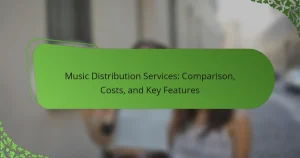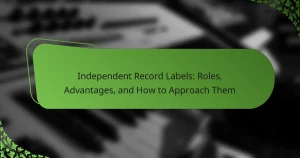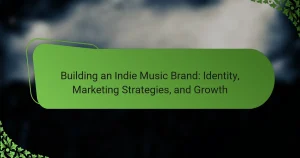Music collaboration tools enhance creativity and streamline communication for musicians, enabling effective teamwork regardless of location. This article explores the types of tools available, their benefits, and top recommendations like Soundtrap, BandLab, and Splice. It also addresses common challenges musicians face and highlights the importance of clear communication and established roles in collaborative projects. Understanding cultural influences can further improve collaboration effectiveness across diverse teams.
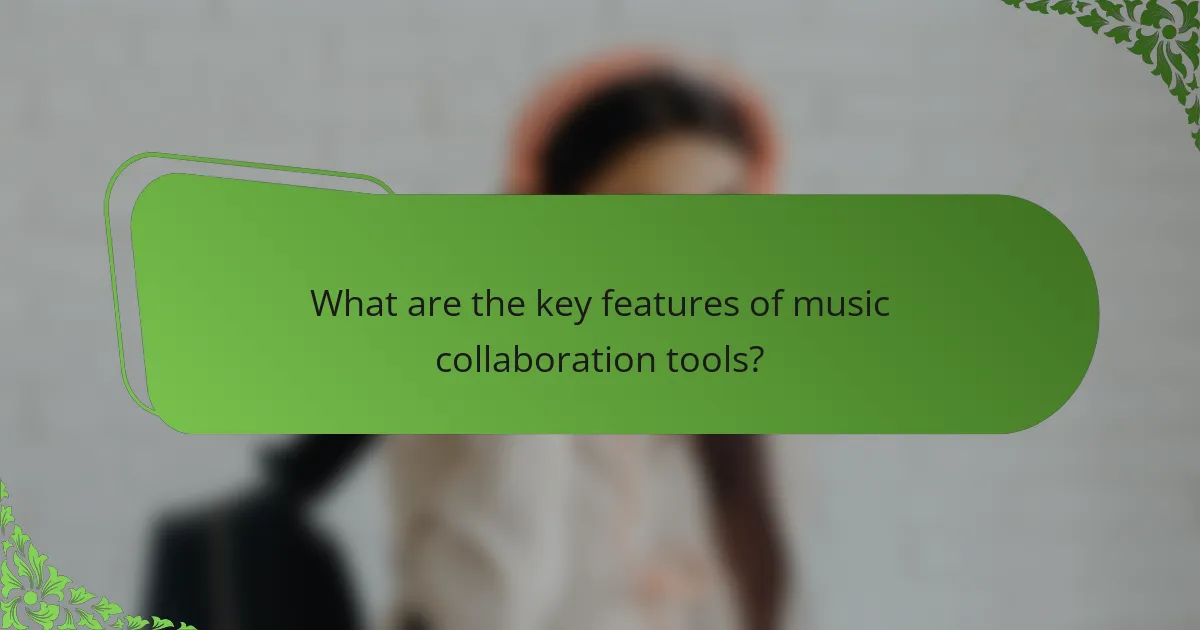
What are the key features of music collaboration tools?
Music collaboration tools enhance teamwork among musicians by providing features that facilitate communication, project management, and creative sharing. Key features include real-time editing, cloud storage, audio/video integration, and user-friendly interfaces. These attributes streamline the creative process, allowing artists to collaborate seamlessly regardless of location. Additionally, tools often offer version control, ensuring that all contributors can track changes and maintain project integrity.
How do music collaboration tools enhance creativity?
Music collaboration tools enhance creativity by facilitating seamless communication, enabling real-time feedback, and allowing diverse input from various artists. These tools foster innovation through shared ideas and collaborative brainstorming. They also provide access to a wider range of sounds and techniques, enriching the creative process. As a result, artists can produce more unique and polished work.
What types of platforms are available for music collaboration?
Several platforms are available for music collaboration, each offering unique features. Common types include cloud-based DAWs, real-time collaboration tools, and project management software. Cloud-based DAWs like Soundtrap allow multiple users to edit tracks simultaneously. Real-time tools like JamKazam facilitate live jam sessions over the internet. Project management software such as Trello helps organize tasks and deadlines for music projects. These platforms enhance creativity and streamline the collaboration process.
Which tools are best for real-time collaboration?
Real-time collaboration tools for music creation include platforms like Soundtrap, BandLab, and Splice. These tools enable musicians to work together seamlessly, regardless of location. Key benefits include immediate feedback, version control, and an integrated workspace for sharing ideas. Popular recommendations feature collaborative features like chat, audio editing, and cloud storage for easy access.
How do different tools cater to various genres of music?
Different tools cater to various genres of music by offering specialized features and functionalities. For example, digital audio workstations (DAWs) like Ableton Live excel in electronic music production, while tools like GarageBand are user-friendly for beginners across multiple genres. Collaboration platforms such as Splice facilitate sharing and remixing, appealing to diverse styles. Additionally, genre-specific plugins enhance sound quality and effects, catering to unique musical needs. This variety allows musicians to select tools that align with their creative goals and genre requirements.
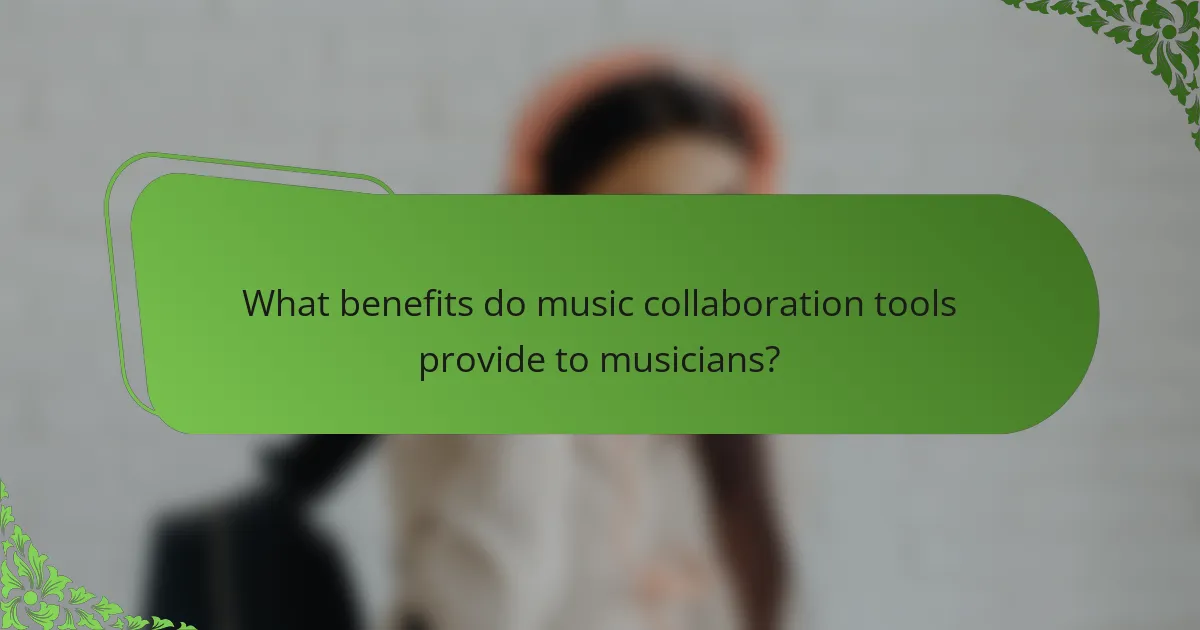
What benefits do music collaboration tools provide to musicians?
Music collaboration tools enhance creativity, streamline communication, and facilitate remote work for musicians. They enable real-time collaboration, allowing artists to share ideas and feedback instantly. These tools often include features like cloud storage, version control, and integrated communication channels, which improve workflow efficiency. Additionally, they provide access to a broader network of collaborators, fostering diverse musical influences.
How can these tools improve workflow efficiency?
Music collaboration tools enhance workflow efficiency by streamlining communication, simplifying project management, and enabling real-time collaboration. These tools allow musicians to share ideas instantly, reducing delays and improving productivity. For example, cloud-based platforms facilitate easy file sharing and feedback, making the creative process more cohesive. Additionally, features like version control help track changes, ensuring everyone stays aligned on project goals. Overall, these tools foster a collaborative environment that accelerates music production.
What role do collaboration tools play in remote music production?
Collaboration tools are essential in remote music production, enabling seamless communication and file sharing among artists. These tools enhance creativity by allowing real-time collaboration, ensuring that musicians can work together despite geographical distances. Popular tools like Zoom, Soundtrap, and Splice facilitate this process by providing features such as audio editing, video conferencing, and cloud storage. As a result, remote music production becomes more efficient and collaborative, leading to higher quality outputs.
How do they facilitate feedback and revisions?
Music collaboration tools facilitate feedback and revisions through real-time editing, commenting features, and version control. These functionalities allow multiple users to provide input simultaneously, ensuring seamless communication. For instance, tools like Soundtrap and Splice enable musicians to leave comments directly on specific sections, making it easier to address concerns. Additionally, version control helps track changes, allowing users to revert to previous iterations if necessary. This enhances the collaborative process, making it efficient and productive.
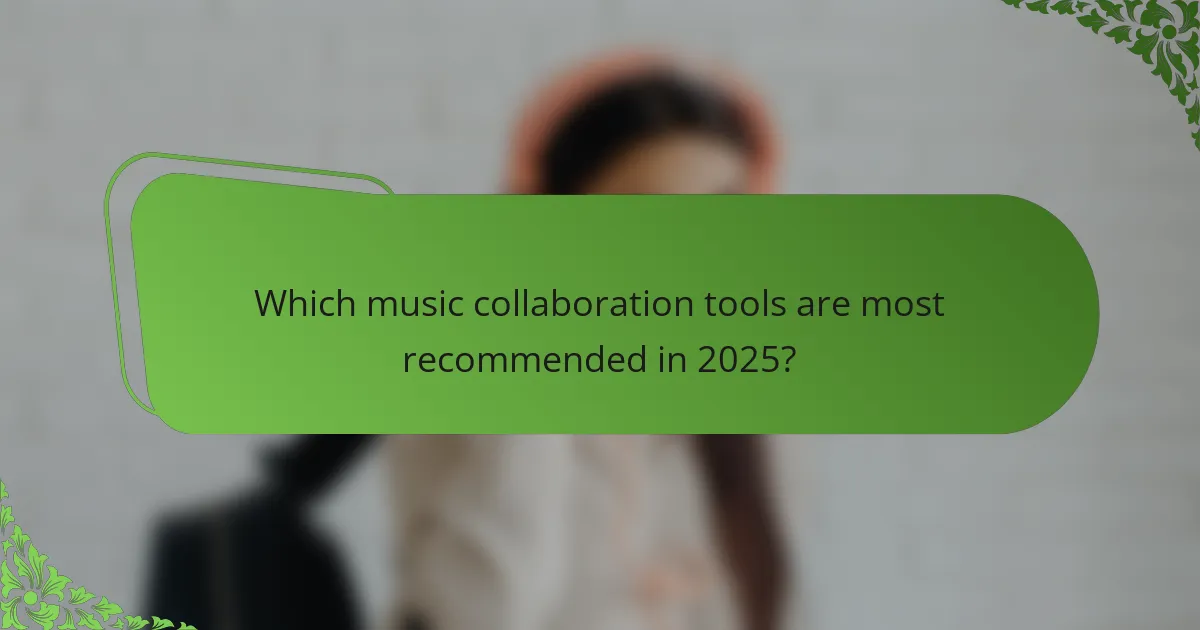
Which music collaboration tools are most recommended in 2025?
In 2025, top recommended music collaboration tools include Soundtrap, BandLab, Splice, and Avid Cloud Collaboration. These platforms enhance creativity and streamline the collaborative process for musicians.
Soundtrap offers cloud-based recording and editing features, making it accessible for remote collaboration. BandLab provides a social platform for musicians to connect and share projects. Splice focuses on sample sharing and project storage, while Avid Cloud Collaboration integrates with Pro Tools for professional-grade music production.
What are the top tools for independent artists?
The top tools for independent artists include collaborative platforms that enhance music creation and sharing. Notable options are Soundtrap, BandLab, and Splice.
Soundtrap offers real-time collaboration features, allowing artists to work together remotely. BandLab provides a comprehensive social network for musicians, facilitating collaboration and feedback. Splice excels in sample management and offers a vast library for creative inspiration.
These tools streamline the creative process, enabling artists to connect, share, and innovate efficiently.
Which platforms are favored by professional producers?
Professional producers favor platforms like Ableton Live, Pro Tools, and Logic Pro X for music collaboration. These tools offer advanced features, seamless integration, and robust community support. Ableton Live excels in live performance capabilities, while Pro Tools is industry-standard for recording and mixing. Logic Pro X provides a comprehensive suite of virtual instruments and effects, making it popular among creative producers. Each platform enhances collaboration through cloud integration and real-time editing features, streamlining the production process.
How do user reviews influence tool selection?
User reviews significantly influence tool selection by providing insights into user experiences and satisfaction. They help potential users assess the effectiveness, usability, and reliability of music collaboration tools. Positive reviews often highlight unique attributes such as integration capabilities or user-friendly interfaces, while negative feedback can reveal rare issues like poor customer support. As a result, reviews serve as a valuable resource for informed decision-making in selecting the right tools for music collaboration.
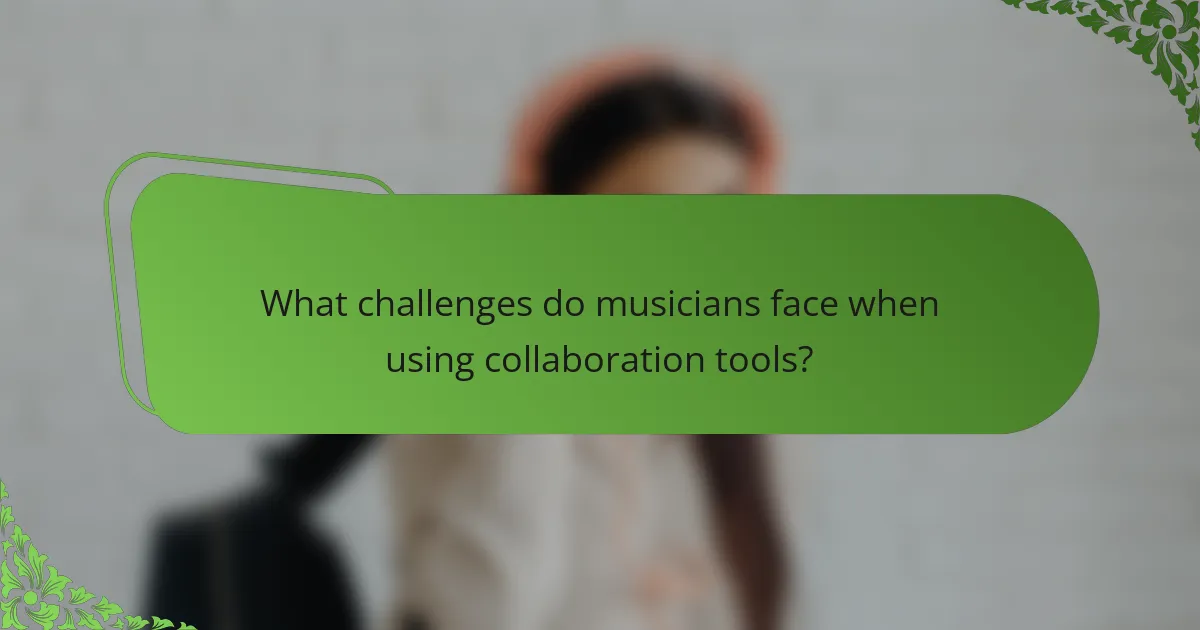
What challenges do musicians face when using collaboration tools?
Musicians face several challenges when using collaboration tools, including technical issues, communication barriers, and varying skill levels. Technical difficulties can disrupt workflow, while communication gaps may lead to misunderstandings. Additionally, differing expertise among collaborators can complicate the creative process. These factors can hinder effective collaboration and impact the overall quality of the music produced.
How can technical issues impact collaboration?
Technical issues can significantly hinder collaboration in music projects. They can lead to delays, miscommunication, and frustration among team members. Common problems include software compatibility issues, internet connectivity failures, and hardware malfunctions. These disruptions can impact workflow and creativity, ultimately affecting the quality of the final product. Ensuring reliable tools and support can mitigate these challenges.
What are common user experience pitfalls?
Common user experience pitfalls in music collaboration tools include poor interface design, lack of real-time collaboration features, insufficient file compatibility, and inadequate support for mobile devices. These issues can hinder creativity and productivity. For example, a cluttered interface can overwhelm users, while limited file formats restrict collaboration. Ensuring user-friendly design and robust functionality enhances the overall experience.
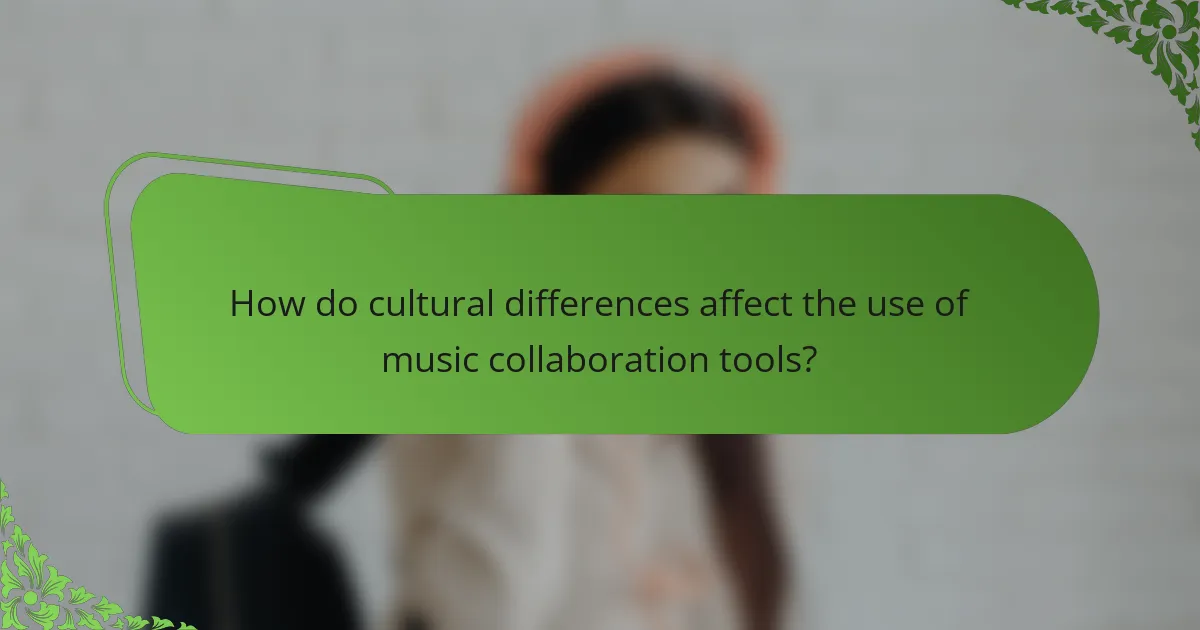
How do cultural differences affect the use of music collaboration tools?
Cultural differences significantly influence the use of music collaboration tools by shaping communication styles and expectations. For instance, some cultures prioritize direct communication, enhancing clarity in collaborative environments, while others favor indirect approaches, which may lead to misunderstandings. Additionally, varying attitudes towards hierarchy can affect how team members interact, with some cultures valuing egalitarian input and others adhering to established authority. Understanding these dynamics can improve collaboration effectiveness and foster creativity across diverse teams.
What trends are emerging in different regions?
Emerging trends in music collaboration tools vary by region, reflecting local preferences and technological advancements. In North America, cloud-based platforms are gaining popularity for their ease of use and accessibility. Europe is seeing a rise in tools that integrate artificial intelligence for music composition and production. In Asia, mobile applications are becoming dominant, allowing musicians to collaborate on-the-go. Latin America emphasizes community-driven platforms that support local genres and cultural expressions. Africa is experiencing growth in tools tailored for collaboration in diverse languages and styles.
How do local music scenes influence tool preferences?
Local music scenes significantly influence tool preferences by shaping artists’ collaboration needs and styles. Regional genres and community dynamics dictate which tools are favored for music creation and sharing. For example, a vibrant hip-hop scene may prioritize beat-making software, while a folk community might lean towards acoustic recording tools. Additionally, local trends can drive the popularity of specific platforms that facilitate collaboration, such as cloud-based services or social media integrations. This localized influence fosters a unique ecosystem where tools evolve to meet the specific demands of the community, enhancing creativity and collaboration.
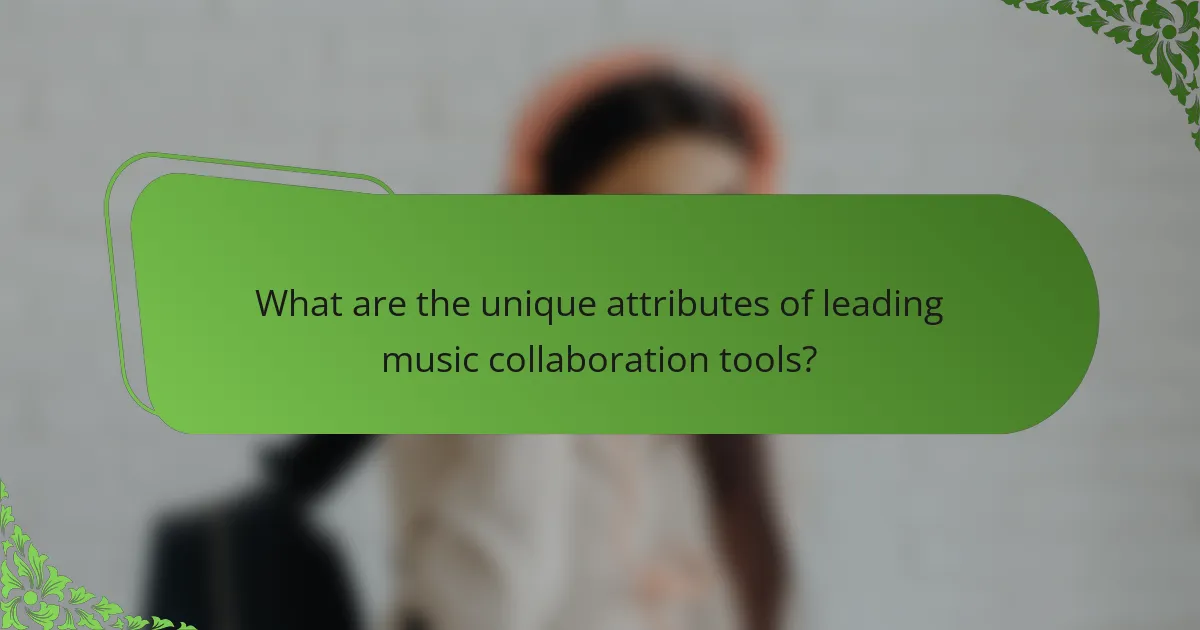
What are the unique attributes of leading music collaboration tools?
Leading music collaboration tools offer unique attributes such as real-time editing, cloud storage integration, and multi-platform accessibility. These features enhance teamwork by allowing seamless interaction among users. Additionally, some tools provide advanced audio editing capabilities, while others focus on user-friendly interfaces. Collaboration tools often support various file formats, ensuring compatibility across different software.
How do specific features differentiate top tools?
Specific features differentiate top music collaboration tools by enhancing usability, functionality, and integration. Key attributes include real-time editing, cloud storage, and cross-platform compatibility. For example, tools like Soundtrap offer seamless collaboration across devices, while BandLab provides extensive social features for sharing. Unique attributes, such as built-in instruments or AI-driven suggestions, set these tools apart, catering to diverse user needs.
What innovative functionalities are being introduced?
Music collaboration tools are introducing innovative functionalities like real-time editing, cloud storage integration, and AI-driven composition assistance. These features enhance creativity and streamline the collaborative process. For example, real-time editing allows multiple users to work simultaneously, improving efficiency. AI-driven tools can suggest chord progressions or melodies, making songwriting easier for users of varying skill levels. Enhanced communication features, such as integrated chat and video calls, further facilitate collaboration across distances.
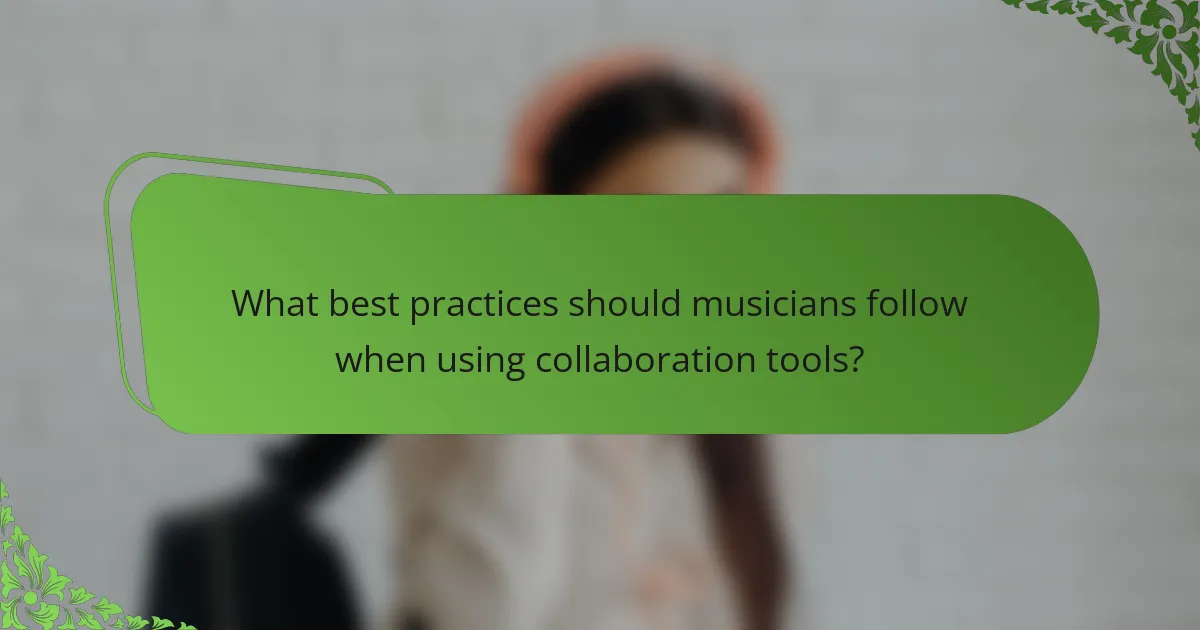
What best practices should musicians follow when using collaboration tools?
Musicians should prioritize clear communication, establish roles, and set deadlines when using collaboration tools. These practices enhance workflow efficiency and ensure that all members contribute effectively. Regular feedback and version control are also essential for maintaining project integrity. Utilizing tools that support real-time collaboration can improve creativity and productivity.
How can artists maximize their collaboration experience?
Artists can maximize their collaboration experience by utilizing effective music collaboration tools. These tools enhance communication, streamline workflows, and facilitate creative exchanges.
Key benefits include improved project management, real-time feedback, and access to a wider range of resources. Top recommendations for collaboration tools are platforms like Splice, Soundtrap, and BandLab, which offer unique features such as cloud storage and integrated social networking.
Incorporating these tools into the creative process fosters a collaborative environment, allowing artists to focus on their artistic vision while efficiently managing their projects.
What common mistakes should be avoided in music collaboration?
To avoid common mistakes in music collaboration, focus on clear communication, defined roles, and open feedback. Misunderstandings can arise from vague expectations, leading to frustration. Additionally, failing to establish a timeline may result in missed deadlines. Lastly, neglecting to use the right collaboration tools can hinder productivity and creativity.
